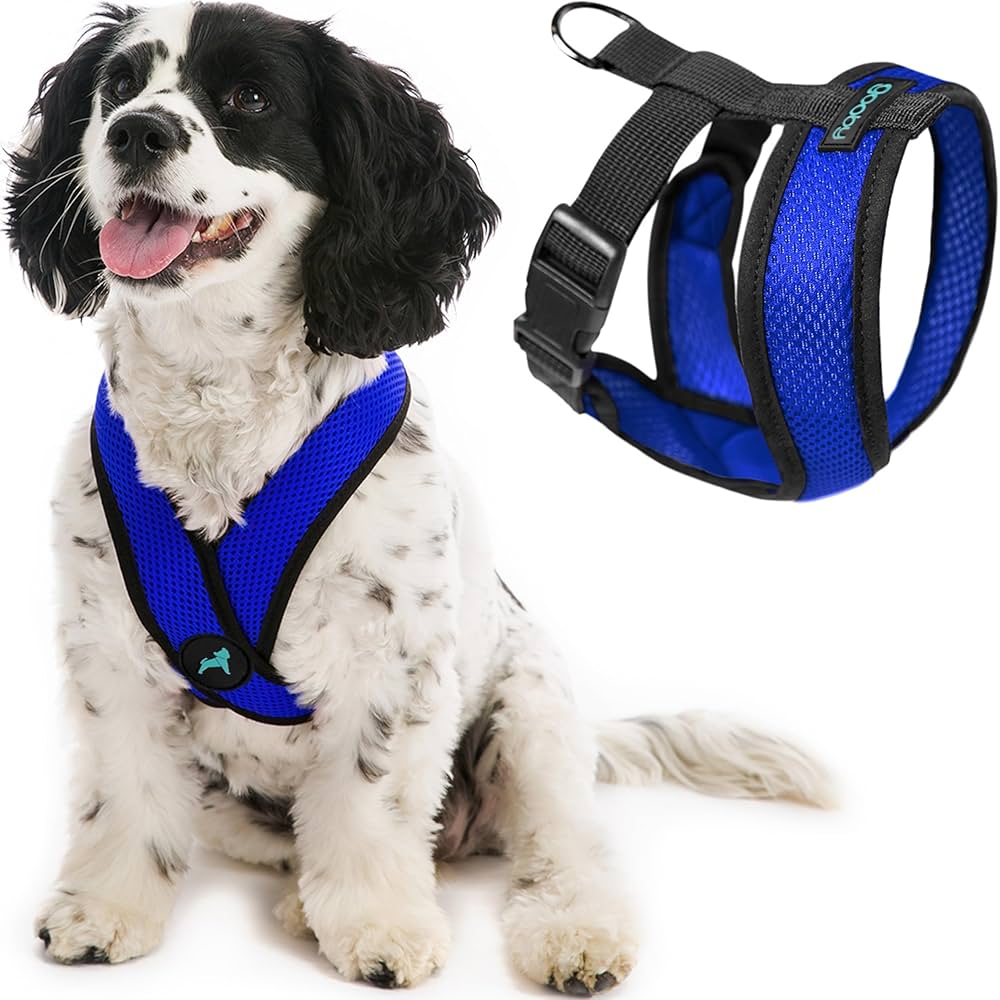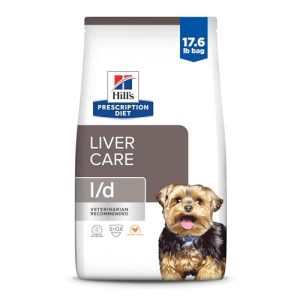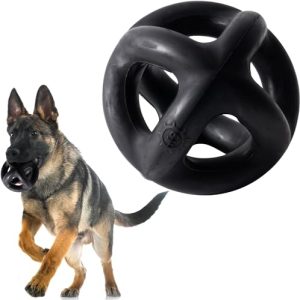If you’ve ever struggled to put a harness on your dog, you’re not alone. Getting your furry friend comfortable and secure can feel tricky at first.
But once you know the simple steps, it becomes quick and stress-free for both of you. You’ll discover exactly how a dog harness goes on your dog the right way. By the end, you’ll feel confident and ready to enjoy walks with your pet like never before.
Keep reading—your dog will thank you!

Credit: walkinpets.com
Choosing The Right Harness
Choosing the right harness for your dog is more than just picking a style you like. It’s about ensuring safety, comfort, and control during every walk. The perfect harness fits your dog's size and personality while making it easy for you to put on and take off.
Types Of Dog Harnesses
There are several types of harnesses, each serving different needs. A back-clip harnessis great for well-behaved dogs and everyday walks. It has a leash attachment on the back, which can give you more control without pulling on the neck.
If your dog pulls a lot, a front-clip harnessmight work better. It redirects your dog’s motion and discourages pulling by attaching the leash at the chest.
For active dogs or those who love hiking, a step-in harnessoffers quick and secure fitting. Think about what your dog does most and pick a style that matches those activities.
Measuring Your Dog
Getting the right size is crucial to prevent chafing or slipping out. Use a soft tape measure to check around your dog’s chest, just behind the front legs, and note the length from neck to chest.
Do you know your dog’s exact measurements? If not, take the time now. Brands often have different sizing charts, so always compare your dog’s dimensions with their guidelines before buying.
Remember, a snug fit that still lets you slide two fingers between the harness and your dog’s body is ideal. Too loose can mean escape risk; too tight can cause discomfort.
Material And Comfort
The material affects how comfortable your dog will feel wearing the harness. Soft, padded fabrics like neoprene or mesh reduce irritation and are great for dogs with sensitive skin.
Durability matters too. Nylon harnesses are tough and easy to clean, but they might not breathe well during hot days. Leather harnesses offer style and strength but require more care.
Check for adjustable straps and quick-release buckles. These features make putting the harness on and off easier for you and less stressful for your dog.

Credit: www.amazon.ca
Preparing Your Dog
Preparing your dog for a harness is a key step for a smooth experience. Your dog needs to feel safe and calm before you put on the harness. Taking time to prepare helps your dog accept the new gear easily. It also builds trust between you and your pet. Start by creating a calm environment with few distractions. This lets your dog focus and stay relaxed.
Calming Techniques
Begin by speaking softly to your dog. Use a gentle voice to soothe any nerves. Pet your dog slowly and calmly to show comfort. Try deep, slow breathing near your dog to lower stress. Offer a favorite treat to create positive feelings. Let your dog sit or lie down comfortably. Keep movements slow and steady. Avoid sudden gestures that might startle your dog.
Introducing The Harness
Show the harness to your dog without putting it on right away. Let your dog sniff and explore the harness at their own pace. Praise your dog for calm behavior near the harness. Hold the harness close to your dog’s body to get them used to the feel. Place the harness near your dog’s resting spot for easy access. Reward your dog with treats while they interact with it. Repeat this for a few days before trying to wear it.
Step-by-step Harness Application
Putting a harness on your dog can be easy and stress-free. The right technique helps your dog feel comfortable and secure. Follow clear steps to make the process smooth for both of you.
Positioning The Harness
Start by holding the harness so the front part faces your dog’s chest. Let your dog stand or sit calmly. Gently slip the harness over their head. Make sure the chest piece rests flat against the dog’s chest. Check the harness is not twisted or inside out.
Securing The Straps
Find the straps that go around your dog’s body. Bring the straps under the belly and behind the front legs. Fasten the buckles securely but gently. Listen for clicks to ensure the clips lock in place. Check that the harness stays in position without slipping.
Adjusting For Fit
Adjust the straps so the harness fits snugly but not tight. You should fit two fingers between the harness and your dog’s body. Make sure the harness does not pinch or rub the skin. Adjust all straps evenly to keep the harness balanced. Watch your dog move to confirm comfort and freedom.
Checking Harness Fit
Checking the fit of a dog harness is important for your pet’s safety and comfort. A harness that fits well allows your dog to move freely without slipping out. It also prevents irritation and injury. Always take time to adjust the straps and check the harness after putting it on.
Comfort And Movement
The harness should fit snugly but not too tight. Your dog should be able to walk, run, and sit comfortably. Watch your dog move to see if the harness shifts or pulls. Make sure the harness does not press on sensitive areas like the neck or armpits.
Avoiding Chafing
Check the harness edges for rough spots or seams that rub against the skin. Look inside the harness padding for any stiff or loose parts. Keep an eye on your dog’s skin after wearing the harness. Redness or hair loss can be signs of chafing.
Safety Checks
- Ensure all buckles and clips close securely.
- Test the harness by gently pulling to check for slippage.
- Make sure the leash attachment is strong and stable.
- Adjust straps evenly to avoid uneven pressure.
Regularly inspect the harness for wear and tear. Replace it if you find cracks or broken parts. A well-fitted harness keeps your dog safe on every walk.
Tips For Harness Training
Getting your dog comfortable with a harness can make walks more enjoyable for both of you. Training your dog to accept the harness calmly takes patience and the right approach. These tips will help you make the process smooth and stress-free.
Positive Reinforcement
Use treats and praise to reward your dog each time they allow the harness to be placed on them. This helps your dog associate the harness with good things, not discomfort. Try giving a small treat before putting the harness on, then another right after securing it.
Keep a cheerful tone and gentle petting during the process. This encourages your dog to relax and trust that the harness isn’t a threat. What reward does your dog respond to best? Use that to make harness time a positive experience.
Short Practice Sessions
Don’t expect your dog to wear the harness for long periods right away. Start with just a few minutes and gradually increase the time as your dog becomes more comfortable. This prevents overwhelming your dog and builds confidence step-by-step.
Try putting the harness on inside your home where your dog feels safe. Take it off before your dog gets restless. This keeps the experience positive and prevents frustration for both of you.
Monitoring Behavior
Watch your dog’s reactions closely during harness training. If your dog shows signs of stress—like pawing at the harness, whining, or freezing—pause and give them a break. Pushing too hard can cause negative associations.
Notice when your dog starts to relax and move normally with the harness on. That’s your cue to slowly increase harness time or move to outdoor walks. How does your dog communicate comfort or discomfort? Paying attention helps you adapt your approach.

Credit: www.amazon.ca
Common Mistakes To Avoid
Putting a harness on your dog might seem simple, but mistakes can cause discomfort or escape risks. Avoiding common errors ensures your dog feels safe and secure. Focus on fit, your dog’s comfort, and choosing the right type.
Too Tight Or Loose
A harness too tight can pinch your dog’s skin and restrict movement. It may cause chafing or breathing trouble. A loose harness can slip off or let your dog escape. Check that you can fit two fingers between the harness and your dog’s body. Adjust straps for a snug but comfortable fit.
Ignoring Dog’s Reactions
Watch your dog’s body language carefully. Signs like pulling away, scratching, or whining show discomfort. Forcing a harness can cause fear or resistance. Take breaks and let your dog get used to the harness slowly. Positive rewards help build trust and acceptance.
Using Wrong Harness Types
Different harnesses suit different dogs and activities. Front-clip harnesses help with pulling but may not fit all breeds. Back-clip harnesses work for casual walks but may not control strong pullers. Check the size chart and pick a harness designed for your dog’s size and shape.
Frequently Asked Questions
How Do You Put A Harness On A Dog?
To put a harness on a dog, start by placing it over their head. Make sure the D-ring is on their back. Then, adjust the straps around the chest and stomach. Ensure a snug fit without being too tight. Check for comfort and security before fastening.
Which Type Of Dog Harness Is Best?
The best harness depends on your dog's size, breed, and behavior. Front-clip harnesses help with pulling. Back-clip harnesses are ideal for well-behaved dogs. Step-in harnesses are convenient for dogs who dislike overhead styles. Always prioritize comfort and durability for your dog's safety.
Can A Harness Hurt My Dog?
A harness can hurt if it doesn’t fit properly. Ill-fitting harnesses can cause chafing or restrict movement. Always ensure the harness is snug but not too tight. Check for any signs of discomfort or irritation. Regularly inspect the harness for wear and tear to avoid injuries.
How Tight Should A Dog Harness Be?
A dog harness should be snug but not tight. You should be able to fit two fingers between the harness and your dog. This ensures comfort and prevents chafing. Regularly check the fit, especially if your dog is still growing.
Adjust as necessary to maintain comfort and security.
Conclusion
A dog harness fits snugly and keeps your dog safe. Start by placing it over the head. Then, secure the straps around the chest and belly. Adjust for comfort without making it too tight. Always check the fit before walking.
A good harness helps control your dog gently. It protects their neck and prevents pulling. Taking time to put it on right matters. Your dog will enjoy walks more with a proper harness. Simple steps lead to safer, happier outings together.

Emily Barker is the founder of ChillDogLife.com, a space dedicated to helping pup parents discover the best dog products, lifestyle tips, and cozy ideas for happier homes.
A lifelong dog lover, Emily combines her passion for pets with a knack for research to share trusted recommendations on everything from toys and furniture to health and everyday care.
Her goal is simple: to make life easier, stylish, and more joyful for dogs and the people who love them.







